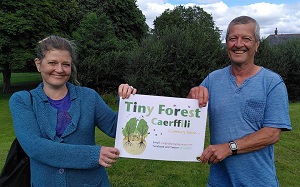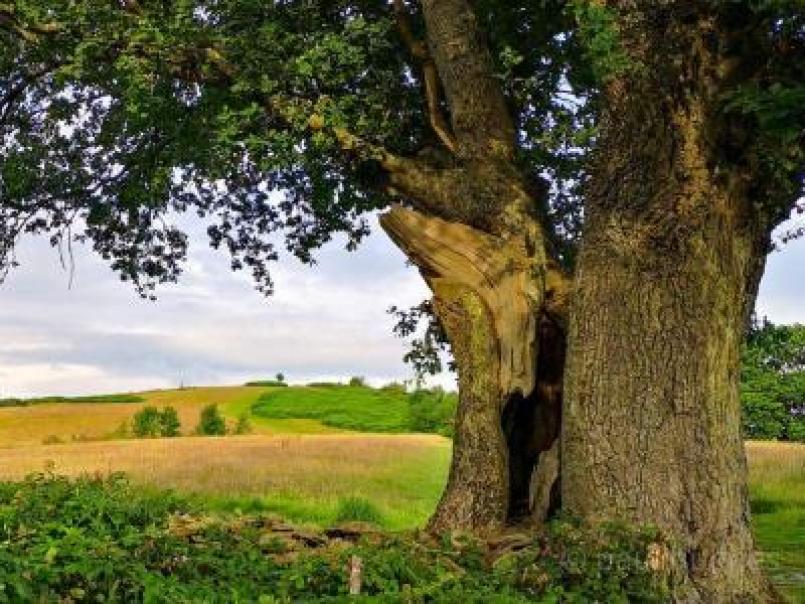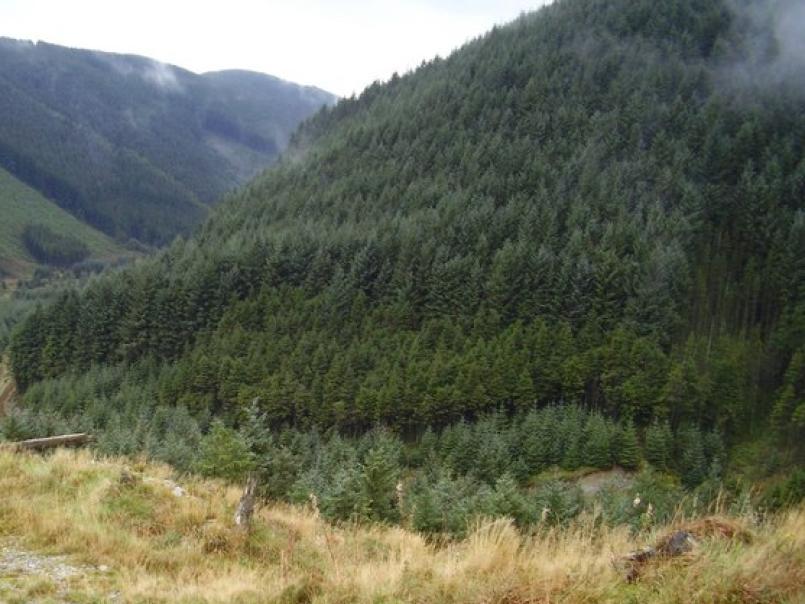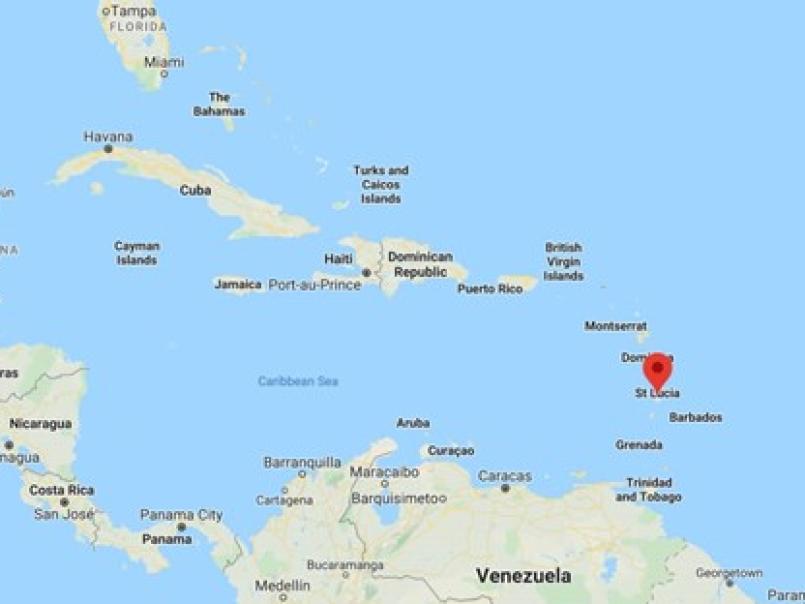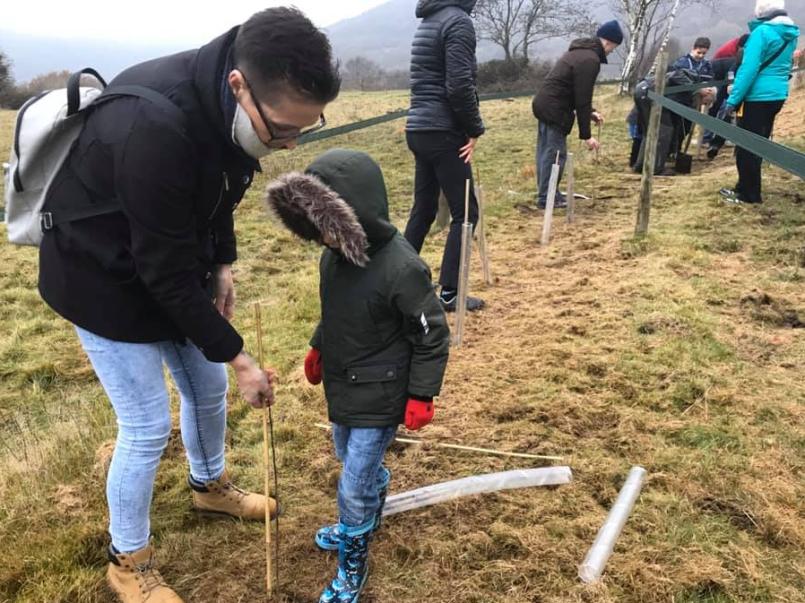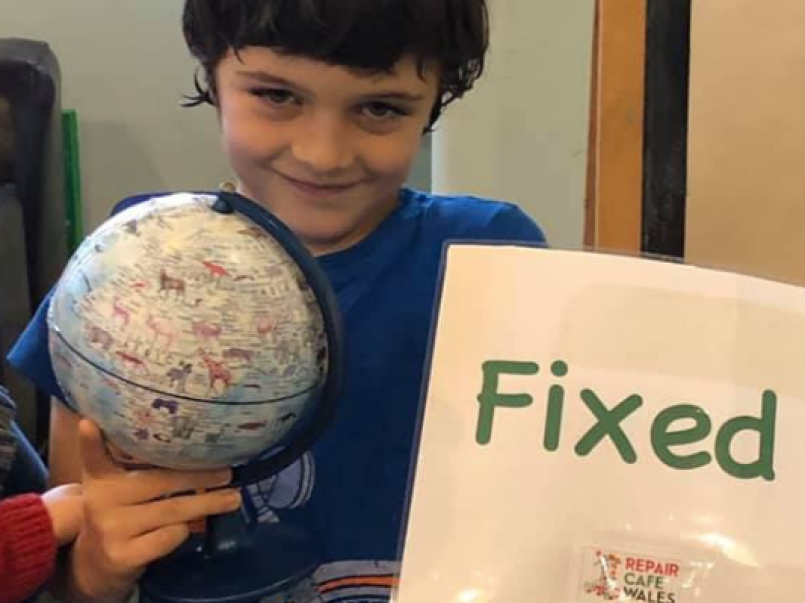How Caerphilly gained a Tiny Forest
Published: 25 Jan 2022
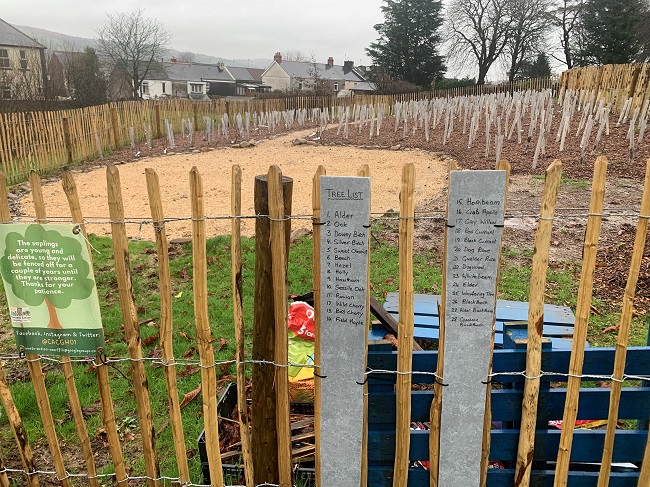
In Morgan Jones Park in Caerphilly, growing on a gentle slope between a children’s playground and a pond fringed with reeds and bulrushes, you will find a "Tiny Forest".
600 saplings (alder, birch, beech, hazel, oak, and other trees native to the area) jostle for space in a fenced enclosure no larger than a tennis court. If you open the gate, you’ll walk into an open, circular space created for forest school activities, then continue along a meandering path through the forest.
Planted only a few months ago, Tiny Forest Caerffili had its roots in discussions on social media channels in early 2020, as the pandemic hit. Thanks to the local council, a grant from the WCVA, and a growing number of volunteers and local businesses, the idea germinated into a plan, and then into an actual forest in early November 2021.
This blog is the story of how we made it all happen and what we learned along the way!
Why a tiny forest?
You may be wondering why we need a Tiny Forest in Caerphilly?
Tiny Forests are based on the growing principles of the Miyawaki Method, the brainchild of a botanist called Akira Miyawaki. Some scientific research has indicated that in the first few years, tiny forests can grow up to 10 times faster and can be up to 20 times more biodiverse than normal forests.
Akira Miyawaki wanted to restore natural vegetation to patches of wasteland, so he planted over 1000 tiny, densely packed forests in his native Japan.
Ideal for small plots of land, Tiny Forests not only provide havens for local wildlife, their trees absorb carbon from the air and they mitigate Climate Change. Their roots soak up rainwater, which can help prevent flooding.
Tiny Forests are a great opportunity for people, especially the younger generation, to connect with nature and with others, and to learn about the wildlife on their doorsteps.
How it started
In Spring and Summer 2020, Caerphilly residents with concerns about climate change were chatting on WhatsApp about what to do next. All of us had attended some ‘Climate Action Kick Off' meetings organised by a newly formed group called Climate Action Caerphilly in late 2019.
Marianne was inspired by the work of Miyawaki, and suggested a Tiny Forest. Morgan Jones Park behind Caerphilly Castle, was proposed as a possible site. It had a community cafe, popular with families, playing fields, and a park that was prone to flooding.
Jamie, who is a local councillor, offered to contact the landowner, Caerphilly County Borough Council. After one or two socially distanced site visits with the County Ecologist Maggie Isles and Simon Beacham from the Parks Department, the council gave us the green light.
The next hurdle was securing funding to turn our dreams into reality.
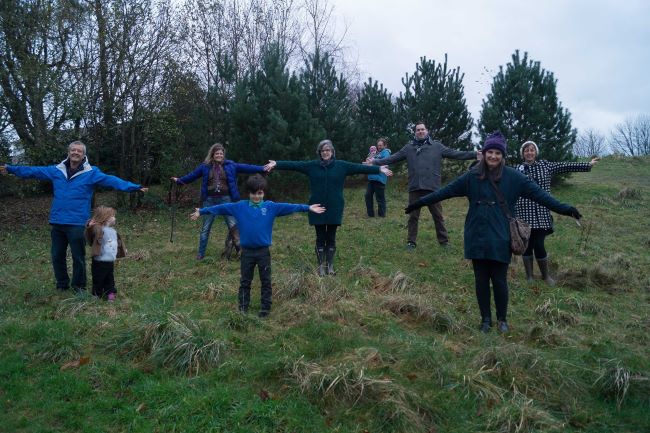
Getting organised
The County Ecologist, Maggie Isles had suggested we apply for the Landfill Disposals Tax Communities Scheme grant from the WCVA. By then, Cath had joined our team, and she has expertise in this area. To be eligible, we had to be a constituted group, with a group constitution, bank account and formal membership for voting on key decisions and roles such as Chair, Treasurer and Secretary. Marianne and Cath worked around the clock to make this happen and quite deservedly were voted Chair and Secretary, respectively.
The funding application was a team effort, with Cath pulling it all together before sending it to the fundraising department of Friends of the Earth for their feedback. In February 2021, we jumped up and down (in our own respective houses!), when we learned we’d been successful. We had little time to reflect - the trees needed to be planted in the Autumn, so we had to get planning!
We divided ourselves into groups - fundraising, publicity, schools, trees and soil working groups, then set to work.
Getting the word out

Our publicity group worked closely with Caerphilly Council’s Communications team to get the word out. Tiny Forest Caerffili was being planted in the run up to the UN Climate Talks, a great hook for journalists who jumped at the opportunity to cover our story. We shared coverage from the BBC, South Wales Argus, and the Caerphilly Observer on our newly created Twitter, Facebook and Instagram accounts. Listen to the BBC Wales Radio coverage here.
We also began to write blogs to document our journey towards creating Tiny Forest Caerffili.
Thanks to a grant from Sustaining Caerphilly’s Landscape Project, we were able to work with a designer on our brand. So, in the lead up to the public planting day (more about this later!) we were armed with a logo and a colour palette, which made it much easier to create eye-catching print and online publicity material.
School engagement
While the Publicity Group was promoting summer workshops (plant and bug hunts), and organising the big planting event, the Schools Group was busy engaging local school children.
Several schools (Hendredenny Primary, Plas y Felin, Rhydri Primary School, Ysgol Gymraeg Caerffili) and young adults from Llamau attended ‘Citizen Science’ biodiversity baseline workshops to record the biodiversity in the site before the trees were planted.
Later, pupils from the same school would visit the site again to plant saplings. First, there was an incredible amount of work to do preparing the site but fortunately we had Terry!
Preparing The Site
None of us had been involved with a Tiny Forest before, but we were fortunate to receive guidance from others, particularly from IVN (Tiny Forest Handbook and on-line course) who have planted around 100 Tiny Forests in Holland and Belgium since 2015.
Terry undertook a soil survey (hand dug trial pits) in December 2020, to check that the chosen site was suitable and to provide information for the grant application.
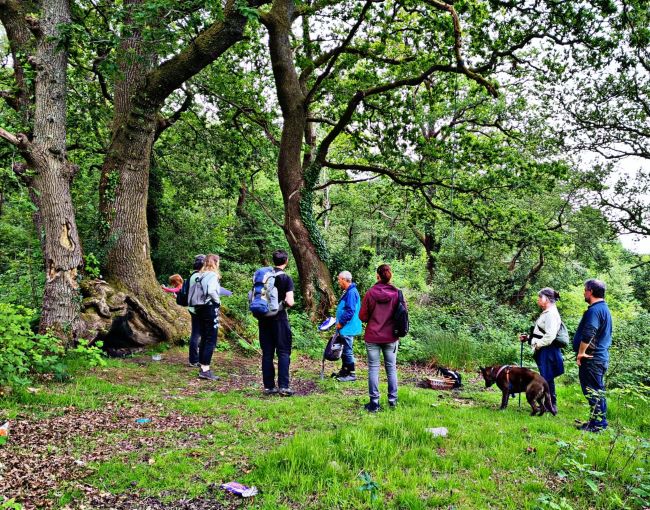
Based on these findings, we arrived at a preferred planting list of 28 native trees and shrubs. Heathwood Nurseries (Shrewsbury) offered the most competitive quote, for 600 cell-grown saplings. We preferred these over bare-rooted whips which would not have become available until late November.
To avoid potential bad weather and wet ground conditions, we intended to prepare the site in late September and plant the Tiny Forest in October. As it turned out, there was a difficulty with procuring the chestnut pale perimeter fencing, so planting was re-scheduled for the first week of November.
Under Terry’s direction, the ground was prepared in late September by a landscape contractor, JS Lee Ltd, working on behalf of the Council. We arranged for the local supply of 5 tonnes of organic soil supplement. It comprised ripe compost, produced from Caerphilly’s green waste and donated by the Bryn Group; mature farmyard manure, donated by Nant y Calch Farm; and chopped straw. Prior to site delivery, these materials were blended at the contractor’s yard, using a rotary mixer.
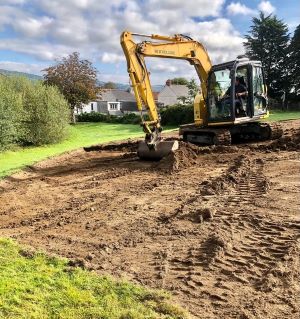
Site preparation involved skimming off a thin layer of turf and topsoil, thoroughly mixing the soil supplement and stripped turf with the underlying soil to 1m depth, then replacing the topsoil layer. This process was repeated section by section across the planting area.
To avoid potential planting obstructions, the cobbles and boulders were hand-picked prior to replacing the topsoil layer. These were used to form edgings to the path and classroom area. Volunteers subsequently constructed the path and classroom, using a base of quarry scalpings, donated by JS Lee Ltd, and a top layer of self-binding gravel.
The chestnut pale fencing was installed by JS Lee Ltd, under contract, during the last week of October.
Planting week
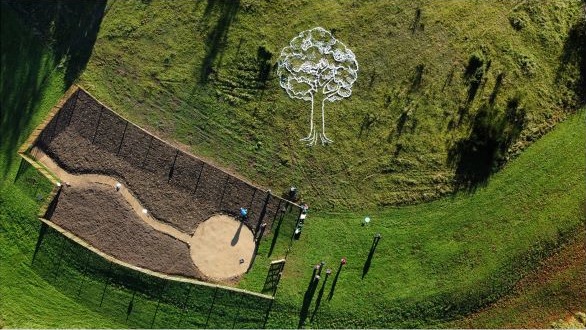
By early November the site was ready. We just needed to plant a few trees - around 600 to be more exact, but we were not short of help!
In the week leading up to the public planting day, local school children from Hendredenny Park Primary, St Martins, Plas Y Felin Primary, Rhydri Primary School, Ysgol Gymraeg Caerffili, Ysgol Gyfun Cwm Rhymni, and Y Gwyndy came to plant trees, take part in a Gratitude Tree land art and help to create a display of wishes and Climate Pledges in the adjoining Old Library Community Cafe.
BBC Wales and Heno (S4C) interviewed the pupils and they featured on the main news and radio.
On 6 November, which was the Global Day of Action for the Climate, over 400 people came to Morgan Jones Park to plant a tree and enjoy the other activities we had planned such as face painting, storytelling, beat boxing, street dancing (which depicted the life cycle of a tree), land art and climate pledges.
Photos from the planting day
Courtesy of Kelly Brightman
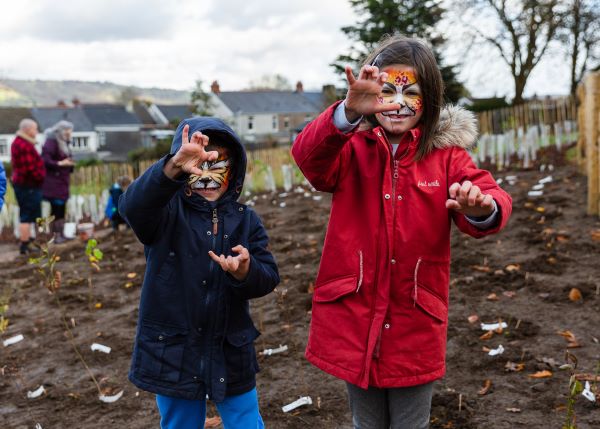
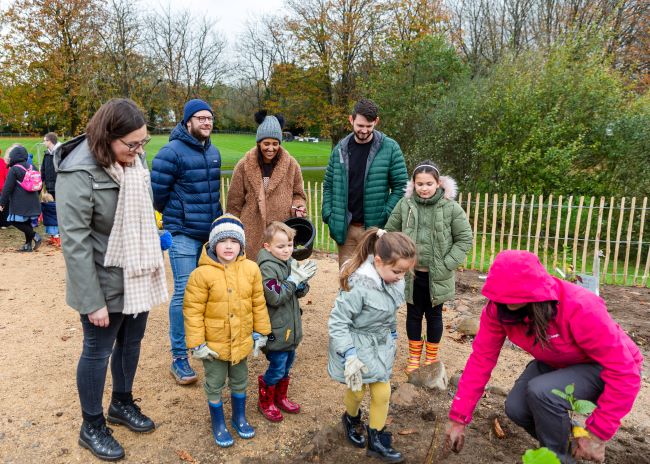

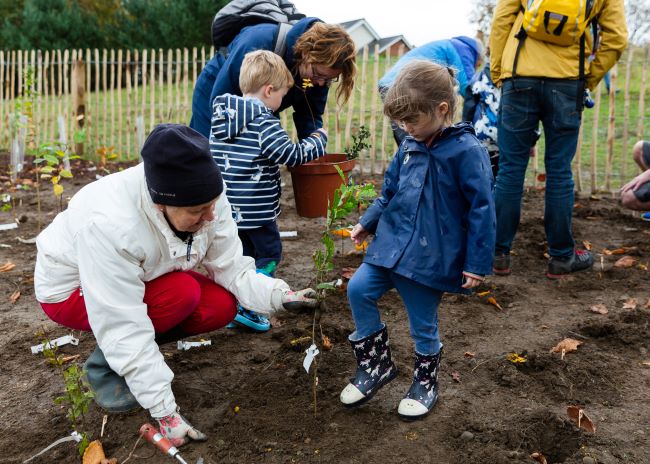
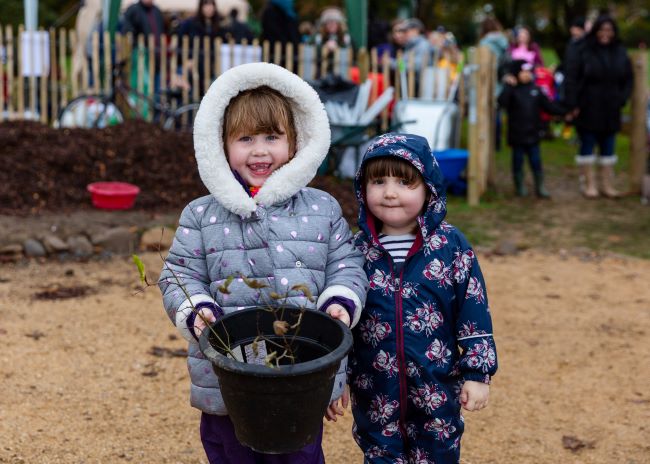
What now?
We will tend to the forest and water it in dry periods, using the water tank which harvests water from the roof of the adjacent church hall, a very long hose and a steep slope.
We are currently making plans for a community event to unveil our Tiny Forest sign. We are also planning to enhance the forest school classroom with bug hotels, raised beds, a bird bath, and forest classroom furniture. Some of us have their Forest School training, others hope to do it. In the long run we would like to undertake educational sessions with local schools and community groups, a very important aspect of the Tiny Forest ethos.
We hope to create disabled access to the Tiny Forest via a board walk along the pond. The council is in agreement, but we are looking at funding possibilities currently to see if it will be possible.
We also plan a programme where adults and children can be forest guardians, to create ownership of the forest in the local community, to foster a love of nature and environmental stewardship.
What we have learned so far
There were not enough of us! We struggled when it came to finding volunteers who had time to commit to the extensive background work needed to fulfill this project. Especially in a pandemic, when illness or isolating meant important people were lost at critical times, leaving the remaining volunteers overstretched. This made us think about the importance of forward planning to create a pool of volunteers. People seem to want to get involved with practical tasks outdoors and we have now started to put together a data base of volunteers who don't want to commit to meetings, but like working outside. A call out during planting week brought an influx of helpers and made the days far more enjoyable.
Being "talk of the town" can be a good thing. We learned about the importance of community networking, community building and outreaching. We particularly excelled at making sure everything was locally sourced and as beneficial to the local community as possible. This helped build the projects popularity and increased it's significance to our Caerphilly community, who attended in high numbers. For example, Father Kelly from the church next to the park let us use the grounds to keep the water tank in to water the forest. He publicised the event on his newsletter and to his congregation. He attended on the day and was very excited, inspiring others!
Thank you!
We would like to thank the following:
Representatives from Caerphilly County Borough Council:
- Simon Beacham, Margaret Iles Phillipa Marsden, Jamie Pritchard
Funding:
- WCVA
- Sustaining Caerphilly’s Landscape Project
Help and donations:
- Bryn Group - compost
- Collin Elsbury - trees
- Daan Bleichrodt - IVN - advice, information, course.
- Friends of the Earth - advice and expertise
- John Hickman (Witney Tiny Forest, Oxford) - advice
- J S Lee Ltd contractor - scalpings
- Mighty Oaks Tree Solutions - woodchip for mulch
- Nant y Calch Farm - manure
- Pat Jones Jenkins - advice
- Ron Davies - advice (trees, ecology)
- Ruperra Conservation Trust - recycled tree guards
- Father Kelly and St Helens Roman Catholic Church - housing water tank
Businesses:
- Rose Innes Designs
- The Old Library
- Inka Print
- Kelly Daniel Photographer
Media:
- Ben Price, BBC
- Lewis Rhys Jones - Heno S4C
Arts and Enrtainment:
- David Van Eker
- Kate Raggett Landscape Artist
- Megan Lloys Storyteller
- Nyell Graycloud - Beatboxer
- Uncle Matt facepainting
Schools and Education
- Hendredenny Park Primary
- Plas Y Felin Primary
- Rudry Primary School
- St Martins Comprehensive
- Ysgol Gyfun Cwm Rhymni
- Ysgol Gymraeg Caerffili
- Llamau
Individuals
- Delyth Jewell
- Colin Elsbury
- Hefin David
- Wayne David

